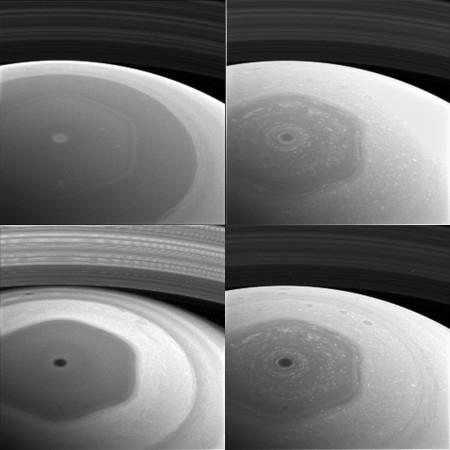NASA's Cassini spacecraft recently took images of Saturn's northern hemisphere, including the pictures of the ringed planet's mysterious hexagon-shaped jet stream.
Cassini's journey had commenced on November 30 and the spacecraft had started its mission Endgame on Sunday, December 4 at 1:09 pm GMT (8:09 am EST). The spacecraft had covered a distance of around 57,000 miles above the gas giant planet's cloud, while the ring grazing the planet's outermost 500 miles thick ring, called the F-ring, from a distance of 6,800 miles.
According to the schedule, Cassini will graze Saturn's rings around 20 times in the coming months. The spacecraft is carried above Saturn's northern hemisphere by its week-long orbits before it glides by the outer edges of the main rings of the planet.
On December 2 and 3, two days prior to when Cassini skimmed the F ring of the planet for the first time, the spacecraft had captured some amazing images of Saturn's northern hemisphere. We will get to see some of the closest photos of Saturn's moons and outer rings that will be snapped by Cassini in the future.
Have a look at the intriguing images:

"This is it, the beginning of the end of our historic exploration of Saturn. Let these images -- and those to come -- remind you that we've lived a bold and daring adventure around the solar system's most magnificent planet," said Carolyn Porco, Cassini imaging team lead at Space Science Institute, Boulder, Colorado, NASA quoted in a statement.
On December 11, Cassini will be passing by the outer edges of Saturn's rings. The mission will continue till April 22, 2017, till when the spacecraft will fly by Saturn's moon Titan closely; this will be followed by a change in Cassini's path again.
On April 26, 2017, Cassini's Grand Finale will begin, when the spacecraft will fly above the rings through the planet and its innermost ring while making 22 plunges.
This Saturn exploring mission will be concluded after Cassini's final dive into the planet's atmosphere, which will take place on September 15, 2017. Information regarding the composition of the planet's atmosphere will be transmitted to Earth till its signal will be lost completely.
Cassini was launched way back in 1997 and it has been exploring Saturn's system since 2004 while focusing on the planet's moons and rings.
The spacecraft even revealed significant findings like discovering a global ocean indicating towards hydrothermal activity within Saturn's moon Enceladus. Another great discovery that the spacecraft made was uncovering the presence of seas made up of liquid methane on Titan, which is another moon orbiting Saturn.









!['Lip lock, pressure, pyaar': Vidya Balan- Pratik Gandhi shine in non-judgmental infidelity romcom Do Aur Do Pyaar [ Review]](https://data1.ibtimes.co.in/en/full/797104/lip-lock-pressure-pyaar-vidya-balan-pratik-gandhi-shine-non-judgmental-infidelity-romcom.jpg?w=220&h=138)








